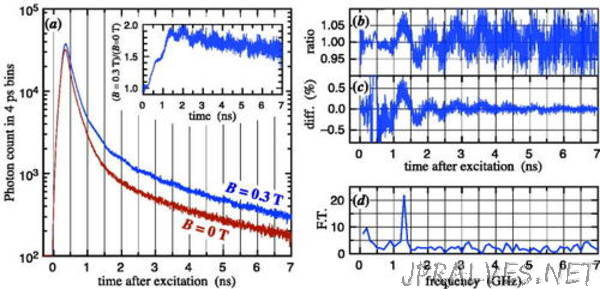
“We observe quantum beats in the nanosecond-scale photoluminescence decay of rubrene single crystals after photoexcitation with short laser pulses in a magnetic field in the range of 0.1 to 0.3 T. The relative amplitude of the quantum beats is of the order of 5%. Their frequency is 1.3 GHz when the magnetic field is oriented parallel to the twofold rotation axis of the rubrene molecules and decreases to 0.6 GHz when the magnetic field is rotated to the crystal’s molecular stacking direction. The amplitude of the quantum beats decays alongside the non-oscillatory photoluminescence background, which at low excitation densities has an exponential decay time of 4.0 ± 0.2 ns. We interpret this as the effective lifetime of a multiexciton state that originates from singlet-fission and can undergo geminate recombination back to the singlet state.
In larger organic molecules, the first electronic excited state can have a significantly lower energy in a triplet configuration when compared to the photoexcited singlet configuration. As a consequence, a singlet exciton in an organic molecular crystal can efficiently transition to a pair of triplet excitons with a total spin of zero, which can ultimately dissociate into independent, long-lived triplet excitons. The early observation of a delayed photoluminescence (PL) after photoexcitation with laser pulses first indicated that independent triplet excitons could meet and undergo a fusion process to produce a radiative singlet exciton,1,2 and it was soon recognized that a fission process in which a singlet exciton decays into two triplet excitons was a key source of these free triplets.
However, although the possibility of singlet exciton fission was recognized early on, the fundamental physical mechanism for singlet-triplet conversion has only recently attracted attention,4–13 also prompted by the interest in its potential application in solar energy harvesting.”
